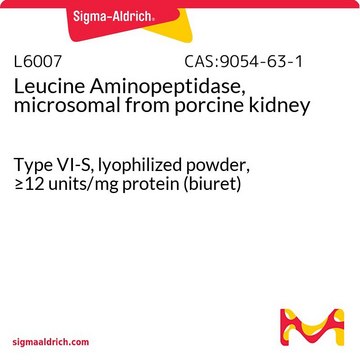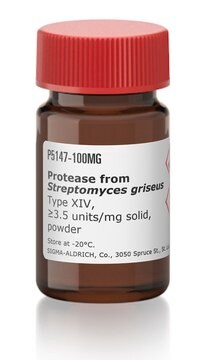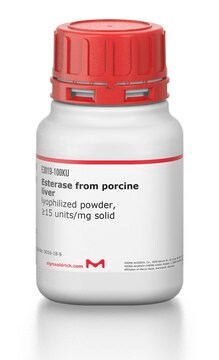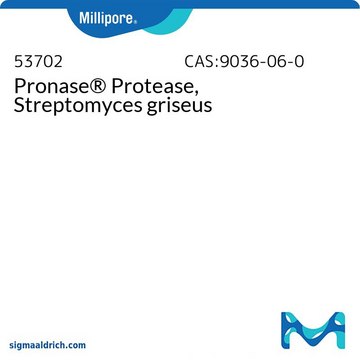P6675
Prolidase from porcine kidney
lyophilized powder, ≥100 units/mg protein
Synonym(s):
Aminoacyl-L-proline hydrolase, Imido Dipeptidase, Prolidase, Proline dipeptidase
Sign Into View Organizational & Contract Pricing
All Photos(1)
About This Item
Recommended Products
form
lyophilized powder
Quality Level
specific activity
≥100 units/mg protein
composition
Protein, 20-74% Lowry
storage temp.
−20°C
Looking for similar products? Visit Product Comparison Guide
Related Categories
General description
Prolidase is a cytosolic exopeptidase. It is a homodimeric enzyme which requires divalent cations like manganese as a cofactor in its active site for its function.
Application
Prolidase from porcine kidney has been used:
- in the enzymatic hydrolysis of porcine milk for the recovery of L-glutamine from proteins and peptides
- in the proteolysis of skim milk for the determination of ε-(γ-glutamyl)lysine and free aminoacids
- to determine its effect on the activity of enterococcin A 2000
Prolidase has an important role in recycling of proline and collagen production. It is used to study mutations in the PEPD gene that cause prolidase deficiency. It is used to hydrolyze proteins with C-terminal proline or hydroxyproline residues. Prolidase, product P6675 from porcine kidney, has been used to hydrolyze peptide bonds from the amino terminus when studying enzymatic methylation of membrane proteins.
Biochem/physiol Actions
Prolidase is an enzyme that catalyzes the hydrolysis of the imide bond between an α-carboxyl group and proline or hydroxyproline. The protein forms a homodimer that hydrolyzes dipeptides or tripeptides with C-terminal proline or hydroxyproline residues.
Rare mutation in prolidase gene causes deficiency leading to massive imidodipeptiduria, elevated proline-containing dipeptides in plasma, recurrent infections, mental retardation and skin lesions.
Unit Definition
One unit will hydrolyze 1.0 μmole of Gly-Pro per min at pH 8.0 at 40 °C.
Physical form
Supplied as a lyophilized powder containing Tris buffer salt and MnCl2.
Signal Word
Danger
Hazard Statements
Precautionary Statements
Hazard Classifications
Eye Irrit. 2 - Resp. Sens. 1 - Skin Irrit. 2 - STOT SE 3
Target Organs
Respiratory system
Storage Class Code
11 - Combustible Solids
WGK
WGK 1
Choose from one of the most recent versions:
Already Own This Product?
Find documentation for the products that you have recently purchased in the Document Library.
Customers Also Viewed
L-Glutamine or L-alanyl-L-glutamine prevents oxidant-or endotoxin-induced death of neonatal enterocytes
Haynes TE, et al.
Amino Acids, 37(1), 131-142 (2009)
Ertugrul Uzar et al.
Neurological sciences : official journal of the Italian Neurological Society and of the Italian Society of Clinical Neurophysiology, 33(4), 875-880 (2011-11-29)
We found no data in the literature related to oxidative stress index (OSI), total oxidative status (TOS) and prolidase activity in patients with diabetic neuropathy (DN). In this study, we aimed to evaluate the oxidative status of DN patients via
Prolidase
Namiduru, ES
Bratislavske lekarske Listy, 117(8), 480-485 (2016)
Casey M Theriot et al.
Archaea (Vancouver, B.C.), 2011, 565127-565127 (2011-12-14)
Prolidases hydrolyze Xaa-Pro dipeptides and can also cleave the P-F and P-O bonds found in organophosphorus (OP) compounds, including the nerve agents soman and sarin. Ph1prol (PH0974) has previously been isolated and characterized from Pyrococcus horikoshii and was shown to
I M Ota et al.
The Journal of biological chemistry, 264(22), 12879-12884 (1989-08-05)
A group of 23-29-kDa polypeptides in the membranes of bovine rod outer segments are substrates for S-adenosylmethionine-dependent methylation reactions. The bulk of the methyl group incorporation is in base-labile ester-like linkages, and does not appear to be due to the
Our team of scientists has experience in all areas of research including Life Science, Material Science, Chemical Synthesis, Chromatography, Analytical and many others.
Contact Technical Service

















